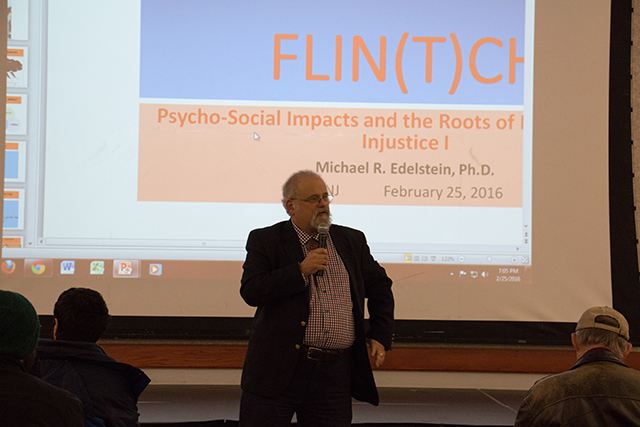
Photo by Pauline Park
Last Thursday, the master’s program in sustainability studies, environmental studies, law and society and Ramapo Green hosted a panel about the complicated current crisis in Flint, Michigan. This crisis involves a wide range of issues, such as contaminated water, racism, lead poisoning, human rights violations and environmental justice.
Sanghamitra Padhy, assistant professor of law and society, opened the discussion by providing a brief overview of the situation. She explained that Flint has been in the news for the past year because of lead poisoning in the water supply system. Because of government action taken in Flint, the water supply system was switched from the Detroit water supply system and moved to Flint River to cut costs. However, when doing so, no assessment was done on the water quality of the river. Chlorides had to be used treat the water because it had E. Coli. Furthermore, the old pipe system was made of lead, which led to serious problems, such as lead poisoning and Legionnaires' disease.
By 2015, there were reports of more and more children in Flint who were exposed to poisoning.
Prior to the panel discussion, Padhy presented a 150-year timeline of the Flint water crisis.
Professor Jan Barry, whose focus is environmental journalism, talked about the nature of reporting that was done in Flint. Berry pointed out that people, including himself, did not know much about or pay much attention to the issue in Flint until major media outlets such as MSNBC and CNN started to report on it heavily. Until then, the Flint crisis was merely a local story. However, Berry also pointed out that, according to NJ.com, 11 cities in New Jersey have more lead-affected kids than Flint, but have not been given such attention. He mentioned that these issues will remain unknown until they are spread around by the media.
Howard Horowitz, professor of geography, focused on the larger issue of lead in the water supply system. Horowitz started off by stating that the history of lead poisoning, and the public policy regarding it, is very complex, and that Flint is “an outrageous example.” He explained that lead has been a toxin since ancient times. During the 20th century, lead poisoning killed thousands of people. Thousands have survived lead poisoning but have suffered physical handicaps. And throughout the 20th century, public policy has been mostly in favor of enterprises and not public health. Michael Edelstein, professor of environmental studies, focused on how contamination continues to impact communities.
Professor Chuck Stead talked about environmental justice issues in Flint. Stead first gave examples of consistent symptoms that are present in those who are exposed to lead. He also raised awareness about the misconception that lead only affects children. Stead criticized, “we all talk about it when it is a sudden crisis.”
“Flint is just the tip of the iceberg,” Stead said.
ppark1@ramapo.edu





